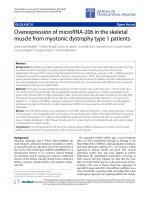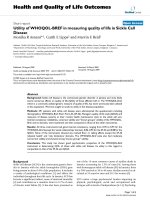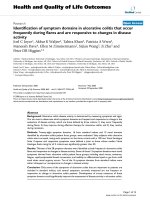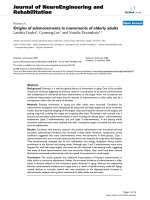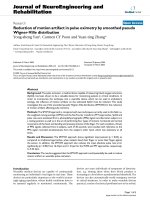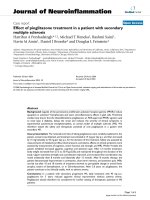Báo cáo hóa học: " Origins of 1/f noise in nanostructure inclusion polymorphous silicon films" ppt
Bạn đang xem bản rút gọn của tài liệu. Xem và tải ngay bản đầy đủ của tài liệu tại đây (487.96 KB, 5 trang )
NANO EXPRESS Open Access
Origins of 1/f noise in nanostructure inclusion
polymorphous silicon films
Shibin Li
1,2
, Yadong Jiang
1
, Zhiming Wu
1*
, Jiang Wu
2
, Zhihua Ying
3
, Zhiming Wang
2*
, Wei Li
1
and
Gregory Salamo
2
Abstract
In this article, we report that the origins of 1/f noise in pm -Si:H film resistors are inhomogeneity and defective
structure. The results obtained are consistent with Hooge’s formula, where the noise parameter, a
H
, is independent
of doping ratio. The 1/f noise power spectral density and noise parameter a
H
are proportional to the squared
value of temperature coefficient of resistance (TCR). The resistivity and TCR of pm-Si:H film resistor were obtained
through linear current-voltage measurement. The 1/f noise, measured by a custom-built noise spectroscopy system,
shows that the power spectral density is a function of both doping ratio and temperature.
Introduction
Nanostructure semiconductor has been the foc us of
intense interest in recent years due to their extensive
device application [1-6]. It is well known that hydroge-
nated polymorphous silicon is a nanostructure inclusion
material [7-9]. Hydrogenated silicon films commonly
exhibit high noise at low frequency (f). This noise has a
spectral power density of the type S(f) ∝ 1/f
a
,wherea is
known as “1/f noise.” However, lower noise materials
are important for high-performance semiconductor
devices. 1/f noise of amorphous and polycrystalline sili-
con has captured the attention of researchers in the
field of electronics and physics for several decades [10].
Polymorphous silicon film is generally prepared by oper-
ating a strong hydrogen-diluted silane plasma source at
high pressure and power density [11]. Many efforts have
been made c oncerning the growth process, microstruc-
ture, transport, and optoelectronic properties of pm-Si:H
films [12]. The results indicate that pm-Si:H films show
higher transport properties than a-Si:H,ahighlydesir-
able trait for the production of devices, such as solar
cells and thin film transistors. To date, pm-Si:H investi-
gations have focused on certain applications, but there
isnostudydevotedtothe1/f noise of such materials
except those by our group which have reported the
dependence of 1/f noise on the change of material struc-
ture of silicon films [13-15]. In this article, we focus on
the study of the origins of 1/f noise in pm-Si:H and
investigate the influence of boron doping ratio on 1/f
noise in pm-Si:H films.
Experimental
The pm-Si:H films were obtained by using RF PECVD
[11]. As shown in Figure 1a, Coplanar nickel electrodes
(about 50 nm) were evaporated onto the pm-Si:H films
and lifted off to make linear I-V contact. In Figure 1b,
in order to reduce external noise disturbance, the mea-
suring circuit was placed in a metal box. The noise and
electri cal measurements were performed at various tem-
peratures using an ESL- 02KA thermostat. Hall measure-
ments were performed using a BioRad HL5560 Hall
system coupled with helium cryostat. The structure of
pm-Si :H films was characterized using a SE850 spectro-
scopic ellipsometer with Bruggeman effective medium
model.
Results and discussions
The results in Table 1 show that pm-Si:H films depos-
ited at higher doping ratio were characterized by high
hydrogen conten t and crystalline fraction, and negligible
void fraction. As shown in Figure 2, because of its nano-
crystalline nature, the crystalline Raman peak of pm-Si:
H exhibits a frequency downshift and peak broadening
* Correspondence: ;
1
State Key Laboratory of Electronic Thin Films and Integrated Devices,
School of Optoelectronic Information, University of Electronic Science and
Technology of China (UESTC), Chengdu 610054, China
2
Arkansas Institute for Nanoscale Materials Science and Engineering,
University of Arkansas, Fayetteville, AR 72701, USA
Full list of author information is available at the end of the article
Li et al. Nanoscale Research Letters 2011, 6:281
/>© 2011 Li et al; licensee Springer. This is an Open Access article distributed under the terms of the Creative Commons Attribution
License ( which permits unrest ricted use, distribution, and repr oduction in any me dium,
provided the original work is properly cited.
Figure 1 Schematic of measurement system. (a) Schematic of coplanar electrode configuration for thin pm-Si:H film resistance measurement;
(b) schematic diagram of low-frequency noise measurement system.
Table 1 Structure and electrical properties for different doping ratios in pm-Si:H film
Sample R
v
h (nm) R
0
(MΩ) N
C
b (%) X
C
(%) H (%) Void (%)
A10
-2
326 2.42 4.24 × 10
14
2.78 20 18 0
B10
-3
335 4.53 3.54 × 10
13
2.93 18 16 0.5
C10
-4
341 6.76 4.23 × 10
12
3.28 17 15 0.8
D10
-5
352 8.21 3.85 × 10
11
3.45 14 13 1
R
v
, gas doping ratio; h, film thickness (nm); N
C
, total number of carriers; TCR value-b (%), TCR = 1/R*(dR/dT)*100; resistivity at temperature of 300 K-R
0
(MΩ); X
C
,
crystal volume fraction (%); H, hydrogen content (%); void, void volume fraction (%).
Li et al. Nanoscale Research Letters 2011, 6:281
/>Page 2 of 5
caused by a phonon confinement effect. A peak (I
n
)is
observed between 480 cm
-1
(I
a
: amorphous silicon) and
520 cm
-1
( I
c
: microcrystalline silicon). The crystalline
volume fraction X
C
of these films has been calculated
from the relation X
C
=(I
n
+ I
c
)/(I
a
+ I
n
+ I
c
)[13].In
this study, the results have proven that the crystalline
volume fractions (X
C
) measured by SE and Raman spec-
troscopy are highly consistent.
Figure 3 shows a logarithmic plot of power spectral den-
sity, which is averaged over 30 measurements, versus fre-
quency for different doping ratios in pm-Si:H films at 300 K.
The decrease of noise is inversely proportional to frequency.
Moreover, the 1/f noise decreased with the increment of
boron doping ratio in pm -Si:H samples. Conventionally, the
results of 1/f noise measurements are discussed using Equa-
tion 1 originally i ntroduced by Hooge [16]:
S
v
V
2
=
α
H
N
C
f
(1)
where S
v
is the noise power density at voltage V, a
H
is
the noise parameter, f is frequency, and N
C
is the total
number of charge carriers in a certain volume involved
in noise generation. The total number of charge carriers,
determined by Hall measurement, in conjunction with
the dimension of the pm-Si:H film resistor, determines
the noise parameter a
H
as a function of frequency. Our
experimental results also demonstrate the 1/f noise
power scales with the square of bias voltage, which is in
agreement with the results of Fine et al. [17].
Figure4showstherelativevoltagenoisepowerS
v
/V
2
at 100 Hz. We obtained that S
v
/V
2
is constant at voltage
less than 1 V, which indicates that 1/f noise i n pm-Si:H
film resistor does not originate from the resistance fluc-
tuations at 100 Hz under our experimental conditions.
Pm-Si:H film is generally accepted as inclusion material
in nanocrystalline and nanosized clusters [18]. The
above results indicate that pm-Si:H films are far from
being homogeneous, and thus, one could predict that
the ir electro nic properties are affected by heterogeneity.
For the clarification of our results, the structure and 1/f
noise variations in amorphous, microcrystalline, and
pm-Si:H films were compared [13]. The results demon-
strate the dependence of 1/f noise in silicon film on the
structure variation. Paul and Dijkhuis [19] proved the
influence of metastable defect creation on the noise
intensity in hydrogenated amorphous silicon. Hence, we
also believe that the defects and heterogeneity cause 1/f
noise in pm-Si:H.
Figure 3 Log-log plot of power spectra density for various
doping ratios in pm-films at 50 mV bias.
Figure 4 Relative noise power at 100 Hz vs voltage.Relative
noise power demonstrates the dependence of 1/f noise in silicon
film on structure variation.
Figure 2 Raman spectroscopy of polymorphous silicon
samples. Raman spectroscopy for pm-Si:H samples (A, B, C, D), the
crystal volume fractions X
C
(%) obtained by Raman is consistent
with the results from SE measurements.
Li et al. Nanoscale Research Letters 2011, 6:281
/>Page 3 of 5
The temperature dependence of 1/f noise in pm-Si:H
film resi stor was also measured at 100 Hz for the various
boron doping pm-Si:H film resistors at temperatures
ranging from 300 to 420 K. In Figure 5a, the 1/f noise in
pm-Si:H film resistor decreases with the increasing tem-
perature. From the theoretical model proposed by Richard,
there is a correlation between S
v
and the temperature
coefficient of resistance (TCR) given by Equation 2 [20]:
S
v
∝
¯
V
2
β
2
(T)
2
(2)
where
¯
V
is the average voltage biased on the sample,
〈(Δ T)
2
〉 is mean-square temperature fl uctuation, and b is
the value of TCR [13]. In the case of our measurement
condition, the value of
¯
V
and 〈(ΔT)
2
〉 is the same for each
film r esistor. Therefore, the power spectral density o f 1/f
noise in pm-Si:H film resistors is proportional to squared
b (S
v
(f) ∝ b
2
). The TCR is a function of resistivity in pm-Si:
H film resistors, which means that resistance fluctuation is
another origin of 1/f noise in the pm-Si :H resistors when
the measurement temperature cha nged significantly. Fig-
ure 5b shows that the temperature dependence of the total
charge carrier number in the measured volume also
decreases with increasing boron doping ratio. The more
highly doped the sample (such as sample A) the fewer the
dangling bonds and defects. Therefore, the variation in the
total charge carrier number for the higher-doped pm-Si:H
sample is lower. From Equation 1, we obtain
α
H
=
N
C
f
V
2
S
v
(3)
For each measured sample here, the values of N
C
, f, and
V
2
are constant. The value of noise parameter a
H
at
100 Hz is plotted against temperature for different doping
ratios as shown in the inset of Figure 5b. The noise para-
meter a
H
for the pm-Si:H film resistors in this study is
also a function of the squared TCR (a
H
∝ b
2
). It demon-
strated that t he resistance fluctuati on of the film samples
also resulted in the variation of noise parameter when the
measurement temperature changed dramatically.
Conclusions
The results of this study demonstrated that the origins of
1/f noise in n anostructure inclusion pm-Si:H are the
inhomogeneity and the defective structure in the films.
The power spectral density of 1/f noise is inversely pro-
portional to boron doping ratio, which is consistent with
Hooge’s formula. The value of S
v
/V
2
is constant when the
voltage is less than 1 V, demonstrating that resistance
fluctuationisnottheoriginof1/f noise in pm-Si film
resistors in th e case of constant temperature. At 100 Hz,
the temperature dependence of 1/f noise indicates that
the power spectral density and the noise parameter a
H
are proportional to the squared TCR. It has also been
proven that the resistance fluctuation of the film samples
also results i n the variation of noise parameter when the
measurement temperature changed dramatically.
Abbreviations
TCR: temperature coefficient of resistance.
Acknowledgements
This work was partially supported by National Science Foundation of China
via grant No. 60901034 and 60425101.
Open access
This article is distributed under the terms of the Creative Commons
Attribution Noncommercial License which permits any noncommercial use,
distribution, and reproduction in any medium, provided the original author
(s) and source are credited.
Author details
1
State Key Laboratory of Electronic Thin Films and Integrated Devices,
School of Optoelectronic Information, University of Electronic Science and
Technology of China (UESTC), Chengdu 610054, China
2
Arkansas Institute for
Nanoscale Materials Science and Engineering, University of Arkansas,
Fayetteville, AR 72701, USA
3
Department of Electronics and Information,
Hang Zhou Dianzi University, Hangzhou, 310018, China
Authors’ contributions
SL designed the experiments, carried out the sample preparation and 1/f
noise measurement. JW and ZY worked on organize data. All authors
participated in discussion on writing. All authors read and approved the final
manuscript.
Competing interests
The authors declare that they have no competing interests.
Received: 18 December 2010 Accepted: 4 April 2011
Published: 4 April 2011
References
1. Li SS, Xia JB: Electronic structure of a hydrogenic acceptor impurity in
semiconductor nano-structures. Nanoscale Res Lett 2007, 2:554.
2. Arendse CJ, Malgas GF, Muller TFG, Knoesen D, Oliphant CJ, Motaung DE,
Halindintwali S, Mwakikunga BW: Thermally induced nano-structural and
Figure 5 Temperature dependence of 1/f noise in pm-Si:H film.
(a) Temperature dependence of 1/f noise in pm-Si:H film. Inset:
temperature dependence of TCR value for samples with various
doping ratios; (b) temperature dependence of total carriers number
(N
C
) on various doping ratios in pm-Si:H films. Inset: temperature
dependence of noise parameter in Hooge’s formula.
Li et al. Nanoscale Research Letters 2011, 6:281
/>Page 4 of 5
optical changes of nc-Si:H deposited by hot-wire CVD. Nanoscale Res Lett
2009, 4:307.
3. Li SS, Xia JB: Linear Rashba model of a hydrogenic donor impurity in
GaAs/GaAlAs quantum wells. Nanoscale Res Lett 2009, 4:178.
4. Li SB, Han L, Chen Z: The interfacial quality of HfO
2
on silicon with
different thicknesses of the chemical oxide interfacial layer. J Electrochem
Soc 2010, 157:G221.
5. Li SS, Xia JB: Electronic structures of GaAs/AlxGa1-xAs quantum double
rings. Nanoscale Res Lett 2006, 1:167.
6. Zhou M, Zhou JY, Li RS, Xie EQ: Preparation of aligned ultra-long and
diameter controlled silicon oxide nanotubes by plasma enhanced
chemical vapor deposition using electrospun PVP nanofiber template.
Nanoscale Res Lett 2010, 5:279.
7. Voyles PM, Gerbi JM, Treacy MMJ, Gibson JM, Abelson JR: Absence of an
abrupt phase change from polycrystalline to amorphous in silicon with
deposition temperature. Phys Rev Lett 2001, 86:5514.
8. Chaâbane N, Kharchenko AV, Vach H, Roca i Cabarrocas P: Optimization of
plasma parameters for the production of silicon nano-crystals. New J
Phys 2003, 5:37.1.
9. Fontcuberta i Morral A, Roca i Cabarrocas P, Clerc C: Structure and hydrogen
content of polymorphous silicon thin films studied by spectroscopic
ellipsometry and nuclear measurements. Phys Rev B 2004, 69:125307.
10. Yoon HP, Yuwen YA, Kendrick CE, Barber GD, Podraza NJ, Redwing JM,
Mallouk TE, Wronski CR, Mayer TS: Enhanced conversion efficiencies for
pillar array solar cells fabricated from crystalline silicon with short
minority carrier diffusion lengths. Appl Phys Lett 2010, 96:213503.
11. Li SB, Wu ZM, Jiang YD, Yu JS, Li W, Liao NM: Growth mechanism of
microcrystalline and polymorphous silicon film with pure silane source
gas. J Phys D 2008, 41:105207.
12. Butté R, Vignoli S, Meaudre M, Meaudre R, Marty O, Saviot L, Roca i
Cabarrocas P: Plasma enhanced chemical vapor deposition of
amorphous, polymorphous and microcrystalline silicon films. J Non-Cryst
Solids 2000, 266-269:263.
13. Li SB, Wu ZM, Jiang YD, Li W, Liao NM, Yu JS: Structure and 1/f noise of
boron doped polymorphous silicon films. Nanotechnology 2008,
19:085706.
14. Li SB, Wu ZM, Li W, Liao NM, Yu JS, Jiang YD: Influence of
microcrystallization on noise in boron-doped silicon film. Phys Status
Solidi A 2007, 204:4292.
15. Li SB, Wu ZM, Jiang YD, Li W, Liao NM, Yu JS: Noise in boron doped
amorphous/microcrystallization silicon films. Appl Surf Sci 2008, 254:3274.
16. Hooge FN: 1/f noise is no surface effect. Phys Lett A 1979, 29:139.
17. Fine BV, Bakker JPR, Dijkhuis JI: Long-range potential fluctuations and 1/f
noise in hydrogenated amorphous silicon.
Phys Rev B 2003, 68:125207.
18. Nguyen-Tran T, Suendo V, Roca i Cabarrocas P, Nittala LN, Bogle SN,
Abelson JR: Fluctuation microscopy evidence for enhanced nanoscale
structural order in polymorphous silicon thin films. J Appl Phys 2006,
100:094319.
19. Paul AWE, Dijkhuis JI: Resistance fluctuations in hydrogenated amorphous
silicon: Thermal equilibrium. Phys Rev B 1998, 58:3904.
20. Voss RF, Clark J: Flicker (1/f) noise: equilibrium temperature and
resistance fluctuations. Phys Rev B 1976, 13:556.
doi:10.1186/1556-276X-6-281
Cite this article as: Li et al.: Origins of 1/f noise in nanostructure
inclusion polymorphous silicon films. Nanoscale Research Letters 2011
6:281.
Submit your manuscript to a
journal and benefi t from:
7 Convenient online submission
7 Rigorous peer review
7 Immediate publication on acceptance
7 Open access: articles freely available online
7 High visibility within the fi eld
7 Retaining the copyright to your article
Submit your next manuscript at 7 springeropen.com
Li et al. Nanoscale Research Letters 2011, 6:281
/>Page 5 of 5


